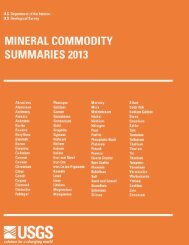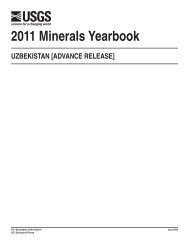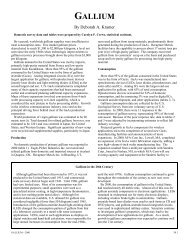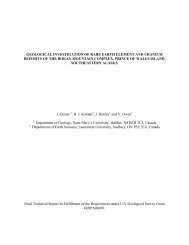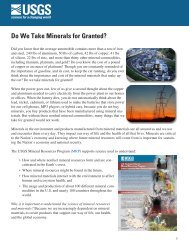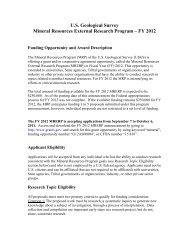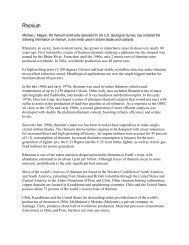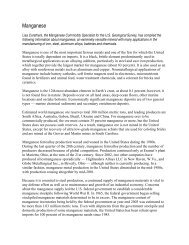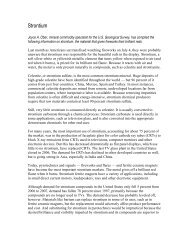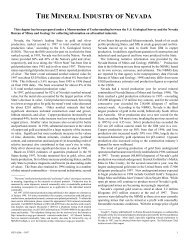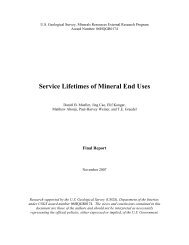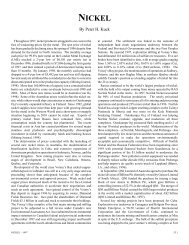Mineral Commodity Summaries 2003 - Mineral Resources Program ...
Mineral Commodity Summaries 2003 - Mineral Resources Program ...
Mineral Commodity Summaries 2003 - Mineral Resources Program ...
Create successful ePaper yourself
Turn your PDF publications into a flip-book with our unique Google optimized e-Paper software.
GARNET (INDUSTRIAL)<br />
Events, Trends, and Issues: During 2002, U.S. garnet consumption decreased slightly, while domestic production of<br />
crude garnet concentrates declined by 11% from that of 2001. In 2002, imports were estimated to have remained<br />
about the same as those of 2001, and exports were estimated to have increased slightly from those of 2001. The<br />
2002 domestic sales of garnet declined slightly from the 2001 level. Since 1999, the United States has moved from<br />
being a net exporter to being a net importer. Garnet imports have displaced U.S. production in the domestic market,<br />
with India becoming a major garnet supplier.<br />
World Mine Production, Reserves, and Reserve Base:<br />
Mine production Reserves 4<br />
Reserve base 4<br />
2001 2002 e<br />
United States 52,700 46,900 5,000,000 25,000,000<br />
Australia 125,000 127,000 1,000,000 7,000,000<br />
China 25,000 27,000 Moderate to Large Moderate to Large<br />
India 60,000 63,000 90,000 5,400,000<br />
Other countries 20,000 21,000 6,500,000 20,000,000<br />
World total (rounded) 283,000 285,000 Moderate Large<br />
World <strong>Resources</strong>: World resources of garnet are large and occur in a wide variety of rocks, particularly gneisses and<br />
schists. Garnet also occurs as contact-metamorphic deposits in crystalline limestones, pegmatites, serpentinites, and<br />
vein deposits. In addition, alluvial garnet is present in many heavy mineral sand and gravel deposits throughout the<br />
world. Large domestic resources of garnet also are concentrated in coarsely crystalline gneiss near North Creek, NY,<br />
and other significant domestic resources of garnet occur in Idaho, Maine, Montana, New Hampshire, North Carolina,<br />
and Oregon. In addition to the United States, major garnet deposits exist in Australia, China, and India, where they are<br />
mined for foreign and domestic markets; deposits in Russia and Turkey also have been mined in recent years,<br />
primarily for internal markets. Additional garnet resources are located in Canada, Chile, Czech Republic, Pakistan,<br />
South Africa, Spain, Thailand, and Ukraine; small mining operations have been reported in most of these areas.<br />
Substitutes: Other natural and manufactured abrasives can substitute to some extent for all major end uses of<br />
garnet. In many cases, however, the substitutes would entail sacrifices in quality or cost. Fused aluminum oxide and<br />
staurolite compete with garnet as a sandblasting material. Ilmenite, magnetite, and plastics compete as filtration<br />
media. Diamond, corundum, and fused aluminum oxide compete for lens grinding and for many lapping operations.<br />
Emery is a substitute in nonskid surfaces. Finally, quartz sand, silicon carbide, and fused aluminum oxide compete for<br />
the finishing of plastics, wood furniture, and other products.<br />
e Estimated. E Net exporter.<br />
1 Excludes gem and synthetic garnet.<br />
2 Includes both crude and refined garnet; most crude concentrate is $50 to $150 per ton, and most refined material is $150 to $450 per ton.<br />
3 Defined as imports - exports + adjustments for industry stock changes.<br />
4 See Appendix C for definitions.<br />
U.S. Geological Survey, <strong>Mineral</strong> <strong>Commodity</strong> <strong>Summaries</strong>, January <strong>2003</strong><br />
69



